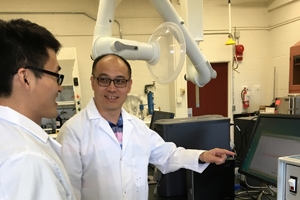Science
Chemistry Chair's Research to Develop High Performance Catalysts

Shouzhong Zou, who joined American University in August 2015 as a professor and chair of the Chemistry Department, works with his team on catalysis research that addresses current issues relating to the environment and energy. Zou and his team are working on three projects: developing platinum (Pt)-based alloy nanocrystals for fuel cell applications, using these catalysts as gas-sensing materials, and developing catalysts for converting carbon dioxide to organic fuels.
Platinum Alloy Nanocrystals
“My research group has been involved in working with metal nanoparticles, with an eye on the applications to catalysis, especially related to fuel cell reactions,” Zou said.
In the past few years, the major focus in Zou’s research has been Pt-based nanocrystals, which are Pt alloys with a second metal. Adding a second metal, which can be most of the first row transition metals, improves the catalytic activity of Pt for oxygen reduction, a fuel cell reaction.
“When you mix Pt with a second metal, it improves the catalytic activity by reducing the adsorption energy of oxygen atoms on the catalyst,” said Zou.
According to Zou, a disadvantage of a pure Pt catalyst is that the Pt-oxygen bond is too strong. The strong interaction of Pt and oxygen helps to break O2 into two oxygen atoms (O), but if the interaction is too strong, the formed oxygen atoms stick on Pt surface and block further O-O bonds from breaking, and the conversion of O to water. By introducing a second component like nickel or cobalt, the Pt-Pt bond shrinks and the oxygen binding to the Pt is decreased. The oxygen reduction reaction will proceed to a completion to form water. The benefit of using a Pt alloy is that the activity is increased, and at the same time, you need less Pt.
Zou explained that his research group does more than just mixing this second metal into Pt. “By controlling the nanoparticles shape, we control the surface structure of the catalyst. For example, we found that the Pt3Ni octahedra, on which the surface atoms are hexagonal close-packed, are much more active than the cubes where the surface atoms line up in a square pattern.”
By using the same material, but in different shapes and compositions, the activity can be engineered. Compared to commercially avail- able catalysts, one of the PtNi catalysts Zou created is about 60 times more active than commercial pure Pt catalysts. It is very promising for fuel cell applications.
In 2015, Toyota deployed the Toyota Mirai, a hydrogen fuel cell vehicle in its North America market. If the fuel cell catalysts Zou works on are implemented in these cars, he thinks that the cost can be greatly reduced.
“We only need 50 percent of Pt in these catalysts, and the activity is 60 times higher so you can use much less Pt to do the same amount of work,” said Zou.
The catalyst is also very stable. Catalysts created by Zou and his team were tested after two years of shelf storage and are still very active, indicating a long shelf life, another promising characteristic of Zou’s catalysts.
Gas Sensors
“We are also working on using these catalysts in gas sensors,” said Zou. In the fracking and oil industry, natural gasses typically are a byproduct of drilling. Natural gas is transported to homes or power plants through pipelines. A leak in a pipeline can result in an explosion, making leak sensors very important in pipelines. In the oil industry, a commonly used sensor is based on lasers, which are expensive and difficult to maintain.
In collaboration with a research group at Oakland University in Michigan, Zou’s group is interested in developing more economically viable sensors to replace those currently used in industry. One method they’re researching is to increase the sensitivity with the help of a catalyst to oxidize methane. In addition to methane, these catalysts could also be used to detect carbon monoxide, formic acid, methanol, formaldehyde, and other compounds that are health hazards.
Converting Carbon Dioxide Back to Organic Fuel
According to a study by NASA, carbon dioxide (CO2) levels in the atmosphere are higher than they’ve been at any point in the past 400,000 years due to the burning of fossil fuels. There is strong evidence that the elevated CO2 concentration is responsible for the climate change we are experiencing.
“As we can see, the fossil fuel industry is not going away soon,” said Zou. “Burning fossil fuels releases a lot of CO2, and if we can convert this CO2 back to organic fuels, such as methanol or formic acid, then we can mitigate this CO2 greenhouse effect.”
Zou’s three areas of research all concern ways to harness energy effectively, cheaply and with as little damage to the environment as possible. “What’s the fundamental reason for my research?” said Zou. “Intellectual curiosity and how to use what we learn for the betterment of the society.”
